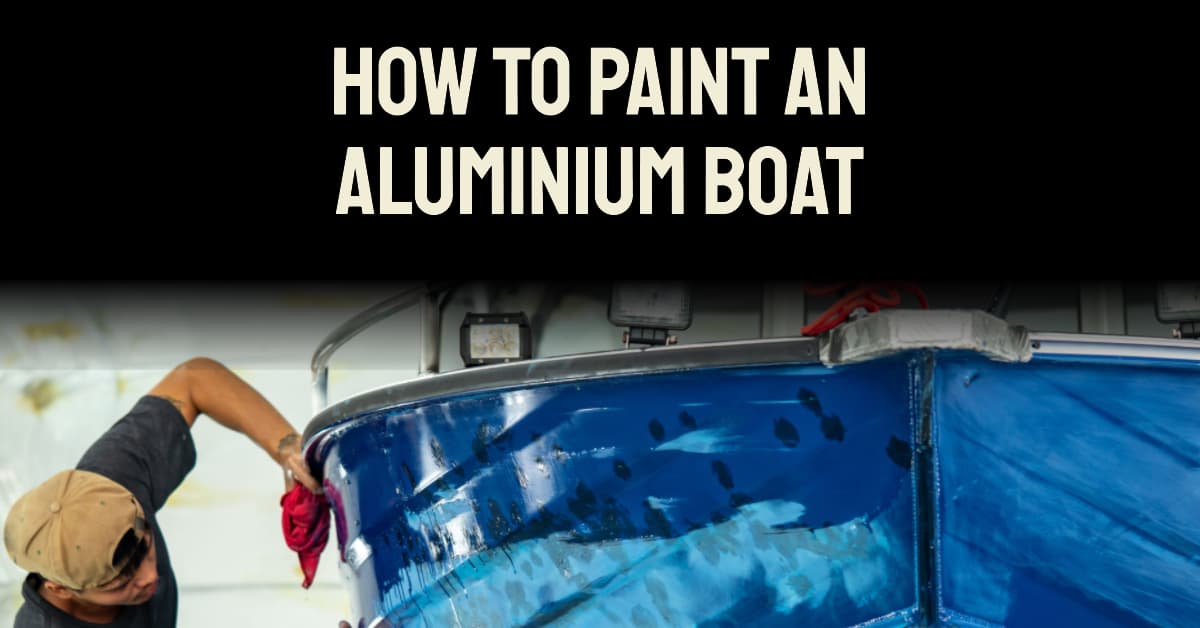You’re probably wondering, “How to paint an aluminium boat?” Well, you’ve come to the right place! Giving your boat a fresh coat of paint not only enhances its appearance but also extends its lifespan by protecting it from harsh weather conditions and corrosive elements.
But painting an aluminium boat is not as simple as slapping on a coat of paint; it takes careful preparation and a little elbow grease.

Preparing Your Aluminium Boat for Painting
Let’s start with the prep work. Like preparing a fine meal, the key to a good paint job lies in the preparation.
Cleaning Your Boat
Just as you wouldn’t start cooking in a dirty kitchen, you don’t want to paint a dirty boat. First off, give your aluminium boat a good wash, removing all the dirt, salt and grime that’s accumulated. You can use a standard garden hose for this, or for a more thorough clean, consider using a pressure washer. Also, make sure to give our comprehensive Center Console Aluminium Boats Guide a quick read for additional care tips!
Materials Needed for Cleaning Your Boat
- Marine-friendly detergent: Star brite Non-Skid Deck Cleaner is a popular choice due to its protective polymers and gentle yet effective cleaning power.
Inspecting Your Boat
After the boat is spick and span, it’s time for inspection. Check for any signs of damage, such as dents or scratches. These could potentially affect the finish of your paint job. If you’re dealing with a 14-foot Jon boat, our guide can provide some useful insights.
Repairing Your Boat
If you find any damage during the inspection, now’s the time to repair it. Small dents and scratches can be filled using an aluminium-friendly filler, which you can find in most marine supply stores. Larger damages, however, might require professional intervention. Always remember: a smooth surface leads to a smooth paint job.
Materials needed for Repairing Aluminuim:
Aluminium-friendly filler: 3M Marine High Strength Repair Filler is highly recommended in the boating community.
Sanding Aluminium Boat
Sanding is the next big step in your “how to paint aluminium boat?” journey.
Removing Old Paint
If your boat has been painted before, you’ll need to remove the old paint before you can apply the new. This can be done using a chemical paint stripper, or by manually sanding the paint off. If you’re doing it manually, be sure to use the right grit of sandpaper. Our Marine Paint for Boats guide gives a detailed account of how to handle this task.
Sanding the Surface
Once the old paint is removed, it’s time to sand the surface. Start with a rough 120-grit sandpaper to remove any remaining paint or primer, then progress to a finer 220-grit to smooth out the surface. Sanding your aluminium boat not only removes unwanted materials but also gives the paint a better surface to adhere to.
Materials needed for Sanding Aluminium Boat
- Sandpaper: Brands like 3M and Dura-Gold offer high-quality sandpaper in various grits.
- Paint stripper (if needed): Dumond Chemicals, Inc. Smart Strip Marine Paint Remover is noted for its effectiveness.
Polishing the Surface
After sanding, you’ll need to polish the aluminium surface. A bit like buffing a car after a wash, this ensures a gleaming surface ready for priming and painting. You can use an aluminum polish and rotary polisher for this, working your way around the boat until you’re left with a smooth and shiny aluminium surface.
Stay tuned for the next part of this comprehensive guide, where we will dive deeper into the priming and painting process. And remember, whether you’re an experienced seafarer or just starting out, painting your aluminium boat is a rewarding task that not only improves your vessel’s aesthetics but also its durability.
Priming Aluminium Boat
So you’ve cleaned, inspected, repaired, and sanded your boat. Now it’s time for one of the most crucial steps in your “how to paint aluminium boat?” journey: priming.
Choosing the Right Primer
Before you start priming, it’s important to choose the right kind of primer. An epoxy primer is often recommended for aluminium boats because it forms a strong bond with the aluminium and creates a good base for the paint to adhere to. The primer not only helps the paint stick to the surface but also adds an extra layer of protection against corrosion.
Applying Primer
When it comes to applying the primer, remember the mantra: thin coats are best. Use a spray gun or a roller to apply the primer evenly over the surface of the boat. Allow each coat to dry thoroughly before applying the next. Two to three coats should be enough to create a strong, even base for your paint.
Materials needed for Priming Aluminium Boat:
Primer: Interlux InterProtect Marine Epoxy Primer is widely recognized for its excellent bonding and protective qualities.
Painting Aluminium Boat
With the boat primed and ready, it’s finally time for the star of the show: the paint.
Choosing the Right Paint
Choosing the right paint is as important as choosing the right primer. There’s a wide range of marine paints available on the market, each with its own advantages and disadvantages. You might want to take a look at our guide on Marine Paint for Boats for more details.
Applying Paint
Like with the primer, apply the paint in thin, even coats. This might require patience, as it’s better to apply several thin coats rather than one thick one. A thick coat of paint can lead to drips and an uneven finish. Take your time and let each coat dry fully before applying the next.
TotalBoat Aluminum Boat Paint or Interlux Brightside Polyurethane Paint are often used for painting aluminium boats. They’re both designed specifically for marine environments and offer a range of colors.
Final Touches
The paint is on, but we’re not done yet!
Applying a Clear Coat
After the paint is fully dry, consider applying a clear sealer or varnish. This step is not mandatory, but it provides extra protection for your paint job and can give your boat a glossy finish that really catches the eye.
Clear Sealer: TotalBoat Krypton Copper Free Antifouling Bottom Paint provides a high-gloss, UV-protected finish that’s perfect for aluminum boats.
Final Inspection
Now that your aluminium boat is painted and sealed, take a step back and inspect your work. Check for any missed spots, drips, or uneven areas. If necessary, you can always touch up small areas with more paint.
Conclusion
Congratulations, you’ve completed your aluminium boat painting project! Here is a quick overview of the aluminium boat painting process.
| Steps | Description | Popular Products |
|---|---|---|
| Cleaning | Remove dirt, salt and grime | Star brite Non-Skid Deck Cleaner |
| Repairing | Fix dents and scratches | 3M Marine High Strength Repair Filler |
| Sanding | Remove old paint and smooth the surface | 3M Sandpaper, Dumond Chemicals, Inc. Smart Strip Marine Paint Remover |
| Priming | Apply primer to create a good base for paint | Interlux InterProtect Marine Epoxy Primer |
| Painting | Apply marine paint evenly | TotalBoat Aluminum Boat Paint, Interlux Brightside Paint |
| Final Touches | Apply a clear sealer for extra protection | TotalBoat Krypton Copper Free Antifouling Bottom Paint |
This process may seem daunting at first glance, but with patience and care, you’ll be rewarded with a boat that not only looks great but also stands up better to the elements. So, whether you’re prepping for the summer season or giving an old boat new life, knowing “how to paint an aluminium boat?” is a skill that will serve you well in your boating adventures.
Remember, the sea may be rough, but with a well-painted boat, you’ll always sail in style.
- Comprehensive Guide to Hold Cleaning for Cargo Ships: Ensuring Maritime Safety and Efficiency – October 19, 2024
- Responsibilities of a Fourth Engineer on Cargo Ships – September 10, 2024
- The Role of Cargo Ships in Global Trade – August 22, 2024




